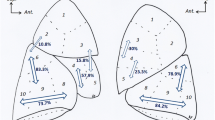Summary
The aim of this study was to describe in detail the anastomoses between the pulmonary lymphatic vessels and the veins of the neck so as to better understand their role in certain aspects of thoracic surgery. The lymphatic vessels of 687 pulmonary segments in 360 cadavers were injected. A detailed study of the proximal end of the right paratracheal, right tracheo-esophageal, left preaortocarotid and left recurrent lymph node chains was undertaken. The results showed the absence of any major right lymphatic “vein”. There were, however, many lymphatic arches draining into the jugulo-subclavian confluence ipsilaterally, and, in 10 to 15% of cases, contralaterally as well. The intertracheobronchial lymph nodes also drained into the venous confluence of the neck via direct lymphatic vessels, without lymph node relays. Finally, the left mediastinal lymph node chains were frequently found to drain into the arch of the thoracic duct (40% of cases), and reflux due to valvular incompetence at this level may account for chylous pericarditis and some cases of chylothorax after surgery.
Résumé
Le but de ce travail a été de préciser les anastomoses lymphaticoveineuses des lymphatiques pulmonaires au niveau cervical et d'essayer d'en mieux comprendre l'intérêt en pratique chirurgicale. L'étude a porté sur 360 cadavres et 687 segments pulmonaires ont été injectés. Les terminaisons des vaisseaux lymphatiques des chaînes lymphonodales prétrachéales droites, trachéo-œsophagiennes, préaortocarotidiennes, récurrentielles gauches ont été particulièrement étudiées. Ce travail a démontré l'absence de grande veine lymphatique droite et l'existence de nombreuses crosses lymphatiques s'abouchant dans les confluents veineux cervicaux homolatéraux mais également controlatéraux dans 10 à 25 % des cas. Le groupe des lymphonoeuds intertrachéobronchiques se drainait lui aussi, malgré son éloignement, dans les confluents veineux cervicaux par des vaisseaux lymphatiques à trajet direct sans interposition de lymphonoeuds. Enfin, les chaînes médiastinales gauches s'abouchaient avec une grande fréquence dans la crosse du conduit thoracique (40 % des cas) et le reflux par incontinence valvulaire de chyle à ce niveau est l'explication anatomique vraisemblable des chylopéricardes et de certains chylothorax post-chirurgicaux.
Similar content being viewed by others
References
Caplan I (1990) Anatomical review of the lymph nodes of the human mediastinum. Surg Radiol Anat 12: 9–18
Riquet M, Debesse B, Hidden G (1989) Les collatérales du canal thoracique d'origine gangliopulmonaire. Étude anatomique et chylothorax après chirurgie pulmonaire. Ann Chir Chir Thorac Cardiovasc 43: 646–657
Rouvière H (1929) Les vaisseaux lymphatiques des poumons et les ganglions viscéraux intrathoraciques. Ann Anat Pathol 6: 113–158
Author information
Authors and Affiliations
Rights and permissions
About this article
Cite this article
Barthes, F.L.P., Riquet, M., Hartl, D. et al. Cervical venous anastomoses of pulmonary lymphatic vessels. Surg Radiol Anat 19, 53–55 (1997). https://doi.org/10.1007/BF01627737
Received:
Accepted:
Issue Date:
DOI: https://doi.org/10.1007/BF01627737




